Chao Zhao
Master Rules from Chaos: Learning to Reason, Plan, and Interact from Chaos for Tangram Assembly
May 17, 2025Abstract:Tangram assembly, the art of human intelligence and manipulation dexterity, is a new challenge for robotics and reveals the limitations of state-of-the-arts. Here, we describe our initial exploration and highlight key problems in reasoning, planning, and manipulation for robotic tangram assembly. We present MRChaos (Master Rules from Chaos), a robust and general solution for learning assembly policies that can generalize to novel objects. In contrast to conventional methods based on prior geometric and kinematic models, MRChaos learns to assemble randomly generated objects through self-exploration in simulation without prior experience in assembling target objects. The reward signal is obtained from the visual observation change without manually designed models or annotations. MRChaos retains its robustness in assembling various novel tangram objects that have never been encountered during training, with only silhouette prompts. We show the potential of MRChaos in wider applications such as cutlery combinations. The presented work indicates that radical generalization in robotic assembly can be achieved by learning in much simpler domains.
Generative Artificial Intelligence in Robotic Manipulation: A Survey
Mar 05, 2025

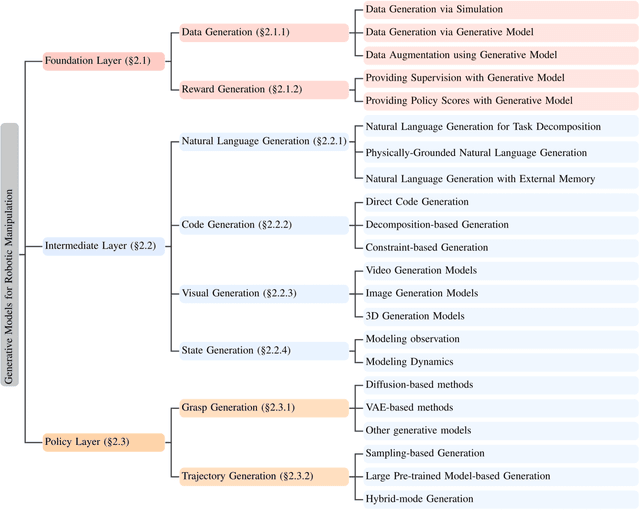

Abstract:This survey provides a comprehensive review on recent advancements of generative learning models in robotic manipulation, addressing key challenges in the field. Robotic manipulation faces critical bottlenecks, including significant challenges in insufficient data and inefficient data acquisition, long-horizon and complex task planning, and the multi-modality reasoning ability for robust policy learning performance across diverse environments. To tackle these challenges, this survey introduces several generative model paradigms, including Generative Adversarial Networks (GANs), Variational Autoencoders (VAEs), diffusion models, probabilistic flow models, and autoregressive models, highlighting their strengths and limitations. The applications of these models are categorized into three hierarchical layers: the Foundation Layer, focusing on data generation and reward generation; the Intermediate Layer, covering language, code, visual, and state generation; and the Policy Layer, emphasizing grasp generation and trajectory generation. Each layer is explored in detail, along with notable works that have advanced the state of the art. Finally, the survey outlines future research directions and challenges, emphasizing the need for improved efficiency in data utilization, better handling of long-horizon tasks, and enhanced generalization across diverse robotic scenarios. All the related resources, including research papers, open-source data, and projects, are collected for the community in https://github.com/GAI4Manipulation/AwesomeGAIManipulation
Learning thin deformable object manipulation with a multi-sensory integrated soft hand
Nov 21, 2024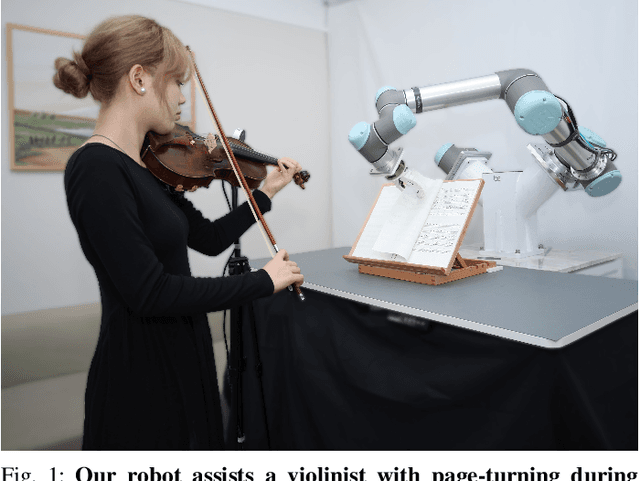
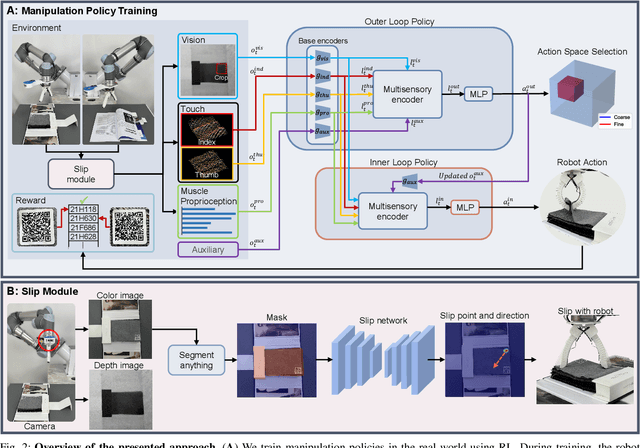
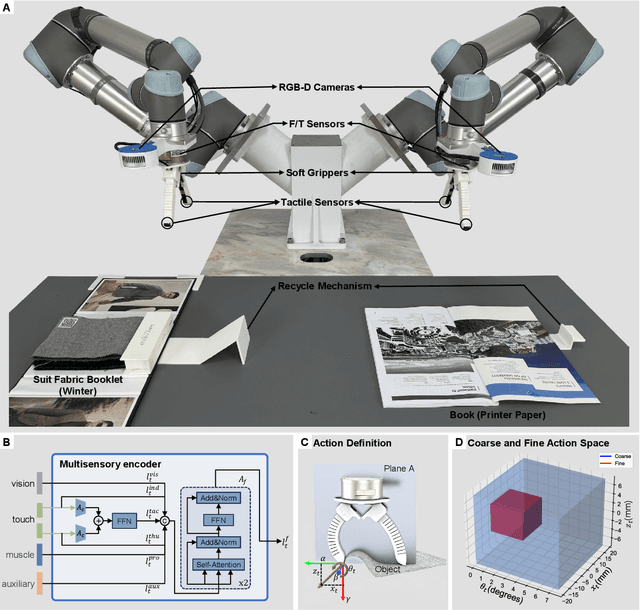
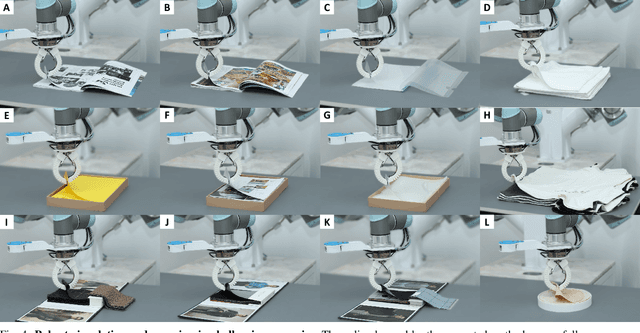
Abstract:Robotic manipulation has made significant advancements, with systems demonstrating high precision and repeatability. However, this remarkable precision often fails to translate into efficient manipulation of thin deformable objects. Current robotic systems lack imprecise dexterity, the ability to perform dexterous manipulation through robust and adaptive behaviors that do not rely on precise control. This paper explores the singulation and grasping of thin, deformable objects. Here, we propose a novel solution that incorporates passive compliance, touch, and proprioception into thin, deformable object manipulation. Our system employs a soft, underactuated hand that provides passive compliance, facilitating adaptive and gentle interactions to dexterously manipulate deformable objects without requiring precise control. The tactile and force/torque sensors equipped on the hand, along with a depth camera, gather sensory data required for manipulation via the proposed slip module. The manipulation policies are learned directly from raw sensory data via model-free reinforcement learning, bypassing explicit environmental and object modeling. We implement a hierarchical double-loop learning process to enhance learning efficiency by decoupling the action space. Our method was deployed on real-world robots and trained in a self-supervised manner. The resulting policy was tested on a variety of challenging tasks that were beyond the capabilities of prior studies, ranging from displaying suit fabric like a salesperson to turning pages of sheet music for violinists.
In-situ Self-optimization of Quantum Dot Emission for Lasers by Machine-Learning Assisted Epitaxy
Nov 01, 2024Abstract:Traditional methods for optimizing light source emissions rely on a time-consuming trial-and-error approach. While in-situ optimization of light source gain media emission during growth is ideal, it has yet to be realized. In this work, we integrate in-situ reflection high-energy electron diffraction (RHEED) with machine learning (ML) to correlate the surface reconstruction with the photoluminescence (PL) of InAs/GaAs quantum dots (QDs), which serve as the active region of lasers. A lightweight ResNet-GLAM model is employed for the real-time processing of RHEED data as input, enabling effective identification of optical performance. This approach guides the dynamic optimization of growth parameters, allowing real-time feedback control to adjust the QDs emission for lasers. We successfully optimized InAs QDs on GaAs substrates, with a 3.2-fold increase in PL intensity and a reduction in full width at half maximum (FWHM) from 36.69 meV to 28.17 meV under initially suboptimal growth conditions. Our automated, in-situ self-optimized lasers with 5-layer InAs QDs achieved electrically pumped continuous-wave operation at 1240 nm with a low threshold current of 150 A/cm2 at room temperature, an excellent performance comparable to samples grown through traditional manual multi-parameter optimization methods. These results mark a significant step toward intelligent, low-cost, and reproductive light emitters production.
DexDiff: Towards Extrinsic Dexterity Manipulation of Ungraspable Objects in Unrestricted Environments
Sep 09, 2024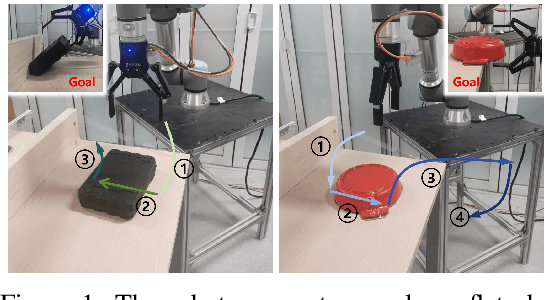

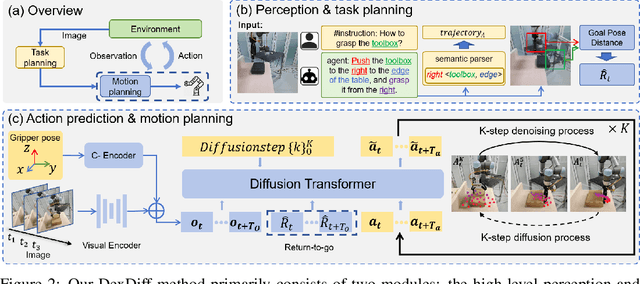

Abstract:Grasping large and flat objects (e.g. a book or a pan) is often regarded as an ungraspable task, which poses significant challenges due to the unreachable grasping poses. Previous works leverage Extrinsic Dexterity like walls or table edges to grasp such objects. However, they are limited to task-specific policies and lack task planning to find pre-grasp conditions. This makes it difficult to adapt to various environments and extrinsic dexterity constraints. Therefore, we present DexDiff, a robust robotic manipulation method for long-horizon planning with extrinsic dexterity. Specifically, we utilize a vision-language model (VLM) to perceive the environmental state and generate high-level task plans, followed by a goal-conditioned action diffusion (GCAD) model to predict the sequence of low-level actions. This model learns the low-level policy from offline data with the cumulative reward guided by high-level planning as the goal condition, which allows for improved prediction of robot actions. Experimental results demonstrate that our method not only effectively performs ungraspable tasks but also generalizes to previously unseen objects. It outperforms baselines by a 47% higher success rate in simulation and facilitates efficient deployment and manipulation in real-world scenarios.
Causal Discovery from Time-Series Data with Short-Term Invariance-Based Convolutional Neural Networks
Aug 15, 2024Abstract:Causal discovery from time-series data aims to capture both intra-slice (contemporaneous) and inter-slice (time-lagged) causality between variables within the temporal chain, which is crucial for various scientific disciplines. Compared to causal discovery from non-time-series data, causal discovery from time-series data necessitates more serialized samples with a larger amount of observed time steps. To address the challenges, we propose a novel gradient-based causal discovery approach STIC, which focuses on \textbf{S}hort-\textbf{T}erm \textbf{I}nvariance using \textbf{C}onvolutional neural networks to uncover the causal relationships from time-series data. Specifically, STIC leverages both the short-term time and mechanism invariance of causality within each window observation, which possesses the property of independence, to enhance sample efficiency. Furthermore, we construct two causal convolution kernels, which correspond to the short-term time and mechanism invariance respectively, to estimate the window causal graph. To demonstrate the necessity of convolutional neural networks for causal discovery from time-series data, we theoretically derive the equivalence between convolution and the underlying generative principle of time-series data under the assumption that the additive noise model is identifiable. Experimental evaluations conducted on both synthetic and FMRI benchmark datasets demonstrate that our STIC outperforms baselines significantly and achieves the state-of-the-art performance, particularly when the datasets contain a limited number of observed time steps. Code is available at \url{https://github.com/HITshenrj/STIC}.
Autonomous, Self-driving Multi-Step Growth of Semiconductor Heterostructures Guided by Machine Learning
Aug 08, 2024Abstract:The semiconductor industry has prioritized automating repetitive tasks by closed-loop, autonomous experimentation which enables accelerated optimization of complex multi-step processes. The emergence of machine learning (ML) has ushered in automated process with minimal human intervention. In this work, we develop SemiEpi, a self-driving automation platform capable of executing molecular beam epitaxy (MBE) growth with multi-steps, continuous in-situ monitoring, and on-the-fly feedback control. By integrating standard hardware, homemade software, curve fitting, and multiple ML models, SemiEpi operates autonomously, eliminating the need for extensive expertise in MBE processes to achieve optimal outcomes. The platform actively learns from previous experimental results, identifying favorable conditions and proposing new experiments to achieve the desired results. We standardize and optimize growth for InAs/GaAs quantum dots (QDs) heterostructures to showcase the power of ML-guided multi-step growth. A temperature calibration was implemented to get the initial growth condition, and fine control of the process was executed using ML. Leveraging RHEED movies acquired during the growth, SemiEpi successfully identified and optimized a novel route for multi-step heterostructure growth. This work demonstrates the capabilities of closed-loop, ML-guided systems in addressing challenges in multi-step growth for any device. Our method is critical to achieve repeatable materials growth using commercially scalable tools. Our strategy facilitates the development of a hardware-independent process and enhancing process repeatability and stability, even without exhaustive knowledge of growth parameters.
Unsupervised, Self-driving Multi-Step Growth of InAs/GaAs Quantum Dots Heterostructures Guided by Machine Learning
Aug 07, 2024Abstract:The semiconductor industry has prioritized automating repetitive tasks by closed-loop, autonomous experimentation which enables accelerated optimization of complex multi-step processes. The emergence of machine learning (ML) has ushered in automated process with minimal human intervention. In this work, we develop SemiEpi, a self-driving automation platform capable of executing molecular beam epitaxy (MBE) growth with multi-steps, continuous in-situ monitoring, and on-the-fly feedback control. By integrating standard hardware, homemade software, curve fitting, and multiple ML models, SemiEpi operates autonomously, eliminating the need for extensive expertise in MBE processes to achieve optimal outcomes. The platform actively learns from previous experimental results, identifying favorable conditions and proposing new experiments to achieve the desired results. We standardize and optimize growth for InAs/GaAs quantum dots (QDs) heterostructures to showcase the power of ML-guided multi-step growth. A temperature calibration was implemented to get the initial growth condition, and fine control of the process was executed using ML. Leveraging RHEED movies acquired during the growth, SemiEpi successfully identified and optimized a novel route for multi-step heterostructure growth. This work demonstrates the capabilities of closed-loop, ML-guided systems in addressing challenges in multi-step growth for any device. Our method is critical to achieve repeatable materials growth using commercially scalable tools. Our strategy facilitates the development of a hardware-independent process and enhancing process repeatability and stability, even without exhaustive knowledge of growth parameters.
Returning to the Start: Generating Narratives with Related Endpoints
Mar 31, 2024Abstract:Human writers often bookend their writing with ending sentences that relate back to the beginning sentences in order to compose a satisfying narrative that "closes the loop." Motivated by this observation, we propose RENarGen, a controllable story-generation paradigm that generates narratives by ensuring the first and last sentences are related and then infilling the middle sentences. Our contributions include an initial exploration of how various methods of bookending from Narratology affect language modeling for stories. Automatic and human evaluations indicate RENarGen produces better stories with more narrative closure than current autoregressive models.
SPECTRUM: Speaker-Enhanced Pre-Training for Long Dialogue Summarization
Jan 31, 2024Abstract:Multi-turn dialogues are characterized by their extended length and the presence of turn-taking conversations. Traditional language models often overlook the distinct features of these dialogues by treating them as regular text. In this paper, we propose a speaker-enhanced pre-training method for long dialogue summarization, which leverages the inherent structure of multiple-turn dialogues. To support our study, we curate a diverse dataset that includes transcripts from real-world scenarios, movie or TV show transcripts, and dialogues generated by a Large Language Model. We then perform a pre-training, which encompasses the detection of speaker changes, and masked utterance generation. Experimental results of fine-tuned models demonstrate that our model achieves state-of-the-art performance on downstream benchmarks with long context, surpassing baseline models and highlighting the effectiveness of our approach. Our findings highlight the importance of curating pre-training datasets that exhibit diversity and variations in length distribution to ensure effective alignment with downstream datasets.
 Add to Chrome
Add to Chrome Add to Firefox
Add to Firefox Add to Edge
Add to Edge